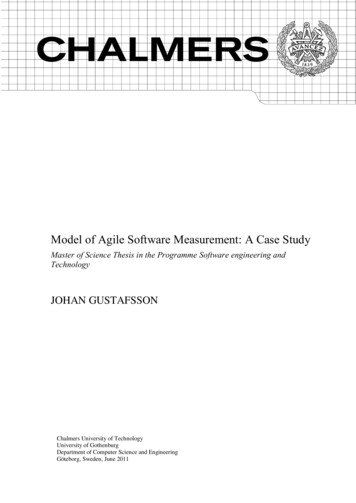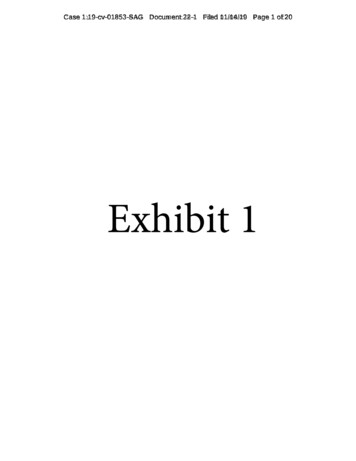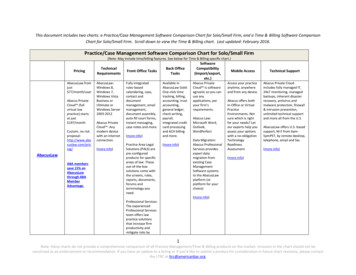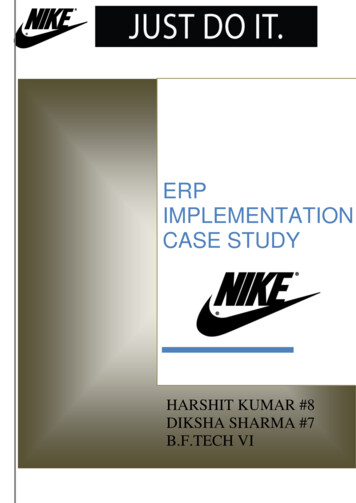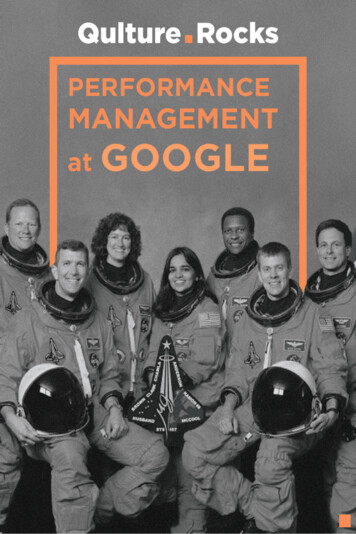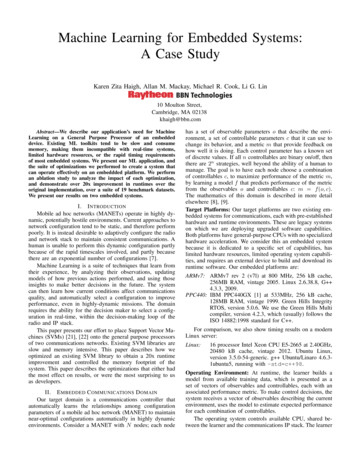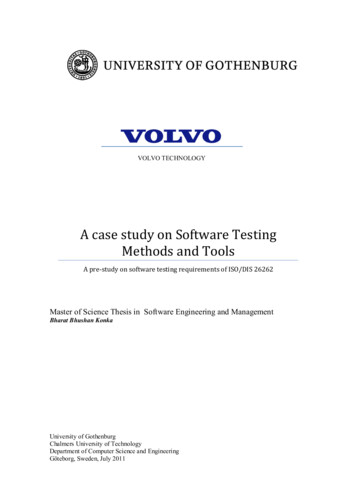
Transcription
VOLVO TECHNOLOGYA case study on Software TestingMethods and ToolsA pre-study on software testing requirements of ISO/DIS 26262Master of Science Thesis in Software Engineering and ManagementBharat Bhushan KonkaUniversity of GothenburgChalmers University of TechnologyDepartment of Computer Science and EngineeringGöteborg, Sweden, July 2011
The Author grants to Chalmers University of Technology and University of Gothenburg the nonexclusive right to publish the Work electronically and in a non-commercial purpose make itaccessible on the Internet.The Author warrants that he/she is the author to the Work, and warrants that the Work does notcontain text, pictures or other material that violates copyright law.The Author shall, when transferring the rights of the Work to a third party (for example a publisheror a company), acknowledge the third party about this agreement. If the Author has signed acopyright agreement with a third party regarding the Work, the Author warrants hereby that he/shehas obtained any necessary permission from this third party to let Chalmers University ofTechnology and University of Gothenburg store the Work electronically and make it accessible onthe Internet.A case study on Software Testing Methods and ToolsA pre-study on software testing requirements of ISO/DIS 26262Bharat Bhushan Konka Bharat Bhushan Konka, August 2011.Examiner: Miroslaw StaronSupervisor: Gerardo SchneiderChalmers University of TechnologyUniversity of GothenburgDepartment of Computer Science and EngineeringSE-412 96 GöteborgSwedenTelephone 46 (0)31-772 1000Cover:This research study was performed at VOLVO TechnologyDepartment of Computer Science and EngineeringGöteborg, Sweden , July 2011Page 2 of 46
Acknowledgements:This thesis would not have been possible without the support from various persons. First of all, Iwould like to thank Volvo Technology (VTEC) for providing opportunity to conduct this researchstudy and also providing necessary resources for this research. I owe my deepest gratitude tosupervisors at Volvo Technology, Marcy Kirk and Camilla Dahl. This thesis could not have beenpossible without their constant guidance and support.I am grateful to my supervisor Dr. Gerardo Schneider from Department of Computer Science andEngineering, Chalmers University, for providing his crucial feedback and guidance during thisresearch.Moreover, I am very thankful to Dr. Dick Stenmark and lecturer Agneta Nilsson from IT Universityfor providing their valuable guidance regarding research methods. I also thank Olof Bridal fromVolvo Technology for providing guidance regarding ISO 26262.Finally, it is a pleasure to thank all the interview respondents from Volvo Technology whoparticipated in this research.Bharat Bhushan KonkaPage 3 of 46
ContentsAbstract . 61. Introduction. 62. Related work & Background . 73. Research Methodology. 83.1 Research Objectives. 83.2 Research Questions . 83.3 Research Method. 83.4 Sampling Strategy for Interviews . 104. Interview results and data analysis . 114.1 Case study setup description. 114.2 Software Testing Methodologies . 124.2.1 Methods and practices . 124.2.2 Test planning activities . 144.2.3 Pre-requisites for testing . 144.2.4 Training and guidelines . 154.2.5 Test cases . 154.2.6 Stopping criteria . 164.2.7 Testing Environment. 184.2.8 Software testing metrics . 184.2.9 Formal Methods . 194.2.10 Impressions and expected improvements on methodologies employed . 204.3 Software Testing Tools. 224.3.1 Activities performed by the tools. 224.3.2 Requirements of specialized tools. 234.3.3 Impressions on tools. 234.3.4 Barriers in automation . 244.4 Software Testing Standards. 244.4.1 Standards being employed . 244.4.2 Barriers in adopting standards. 255. ISO 26262. 255.1 ASIL levels. 255.2 ASIL level of projects at VTEC . 276. Discussion & Recommendations for improvements . 28Page 4 of 46
7. Conclusion. 34Bibliography . 35Appendices . 38A. ISO 26262 Software testing requirements . 38B. Interview Questionnaire. . 41C. Glossary . 43Page 5 of 46
AbstractThis paper presents the findings and analysis done on a case study conducted at Volvo Technology(VTEC, Göteborg, Sweden) for studying the software testing and verification methods, tools andpractices used in automobile domain. This case study was conducted during 2011 (Feb - June). Atotal of 14 interviews were conducted with persons belonging to 2 different departments, 6 groupsand 8 projects. This case study focuses on software testing methods and practices, activitiesperformed with software testing tools and also software testing standards. Based on the outcomes ofthe case study the contemporary practices of software testing in automotive domain are presentedand also some recommendations regarding best practices. This thesis also presents a pre-study onthe forthcoming automobile standard ISO/DIS 26262.1. IntroductionSoftware testing is defined as a formal process in which a software unit, several integratedsoftware units or an entire package are examined by running the programs on a computer. All theassociated tests are performed according to approved test procedures on approved test cases(Galin, 2004). Testing plays a central role in quality assurance activities of many organizations.Finding more efficient ways to perform more effective testing is a key challenge in testing. It isobserved that an efficient testing practice is vital to the quality of the developed product and toreduce the overall development expenses (IEEE, 1990). Galin (2004) explains that software qualityhas a direct relationship with software testing; hence testing is an important phase of the softwaredevelopment life cycle. According to Perry (1995) about 24% of the overall software budget and32% of project management budget is allocated for testing. Due to extra pressure to finish projectson time project managers are likely to reduce the testing activities (Galin, 2004). This can bringadverse effects on software quality, therefore to achieve benefit of software testing under limitedresources, it becomes necessary to identify the best software testing practices and create a mappingbetween various existing software methods and tools. This can be achieved by analyzing currenttesting practices and identifying the improvement potential.Today software is a crucial part of automobile development; it is predominantly used infunctionalities such as driver assistance, vehicle dynamics control, and other active and passivesafety systems. With more usage of software in mechatronics implementation, and increase incomplexity of systems, the possible challenges arising due to systematic failures and randomhardware failures are increased (ISO26262, 2009). Therefore standards are being developed toprovide guidance to automotive based industries to minimize safety related risks to a tolerable level(ISO26262, 2009). The currently available standards such as IEC 61508 on functional safety are notcompletely dedicated towards the automotive domain based industries, and because there ispossibility of interpreting IEC 61508 in different ways it is tough to achieve harmony in functionalsafety within different automotive domain based industries (Schwarz & Buechl, 2009). A new stateof the art standard ISO 26262 is being developed in collaboration of 9 countries: Belgium, Canada,France, Germany, Italy, Japan, Sweden, United Kingdom and USA. It is planned to be released asInternational Standard (IS) in June 2011, the latest draft international standard (DIS) is availablesince June 2009 (Schwarz & Buechl, 2009). Since this new standard will be soon adopted by all themajor automotive domain based industries, it becomes necessary to investigate how the introductionof ISO 26262 standard will affect the existing testing practices in automotive industries.The scientific contribution of this thesis is the study of various software testing practices in aspecific automotive company (Volvo Technology (VTEC)) and investigate how the introduction ofthe new safety standard ISO 26262 will affect the existing testing practices. Also to givePage 6 of 46
recommendations for improvement in the existing testing practices and make a pre-study over theISO 26262 standard, providing suggestions to achieve synergism in terms of testing among differentdepartments within the organization. The intended audiences of this thesis are persons involved insoftware testing activities, and in particular the testing, development teams, and project managers atVTEC.This document will firstly present related work and background, then the research objectives,research method and setup for this case study, latter the analysis of the data obtained frominterviews and literature review on ISO 26262, and finally discussion and recommendation forimprovements based on the patterns emerging from the interview data.Interview data is presented in three different sections addressing software testing methodologies,tools and standards. The data presented in ISO 26262 sections is divided in two different sectionswhich address introduction of ISO 26262 and its ASIL levels and discussion over the applicabilityof the ASIL levels to the projects covered under this case study.2. Related work & BackgroundThere are studies conducted to determine the best testing practices, such as the one by RamChillarege, IBM (Chillarege, 1999) and Antonia Bertolino (Bertolino, 2007). These research studiespresent very significant amount of knowledge on good testing practices, however they are mostlybased on theoretical aspects. This study will try to answer similar research questions with support ofempirical data collected via an industrial case study. Also a survey was conducted in 2004 to studythe software testing practices in Australia by Reed. K. et al. (2004), which provided good insights ofsoftware testing practices useful to design this research study. Another recently published researchstudy by Sundmark et al (2010) presents results of an industrial survey on contemporary aspects ofsoftware testing using qualitative and quantitative methods. Their study gives crucial informationabout discrepancies observed between the current practices and the perceptions of respondentswhich could prove beneficial in shaping future research on software testing, however theexpla
What are the different methods and practices being employed for software testing in automotive industries?And what is the co-relation of these methods and practices with the nature of the projects? 2.What software testing activities are performed with help of software testing tools in automotive domain, in particular at VTEC? 3.
